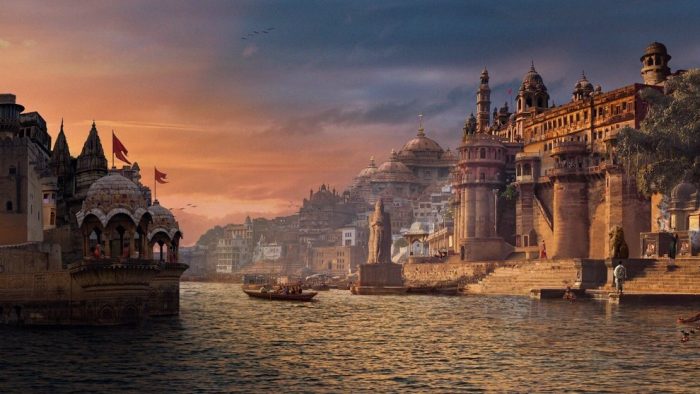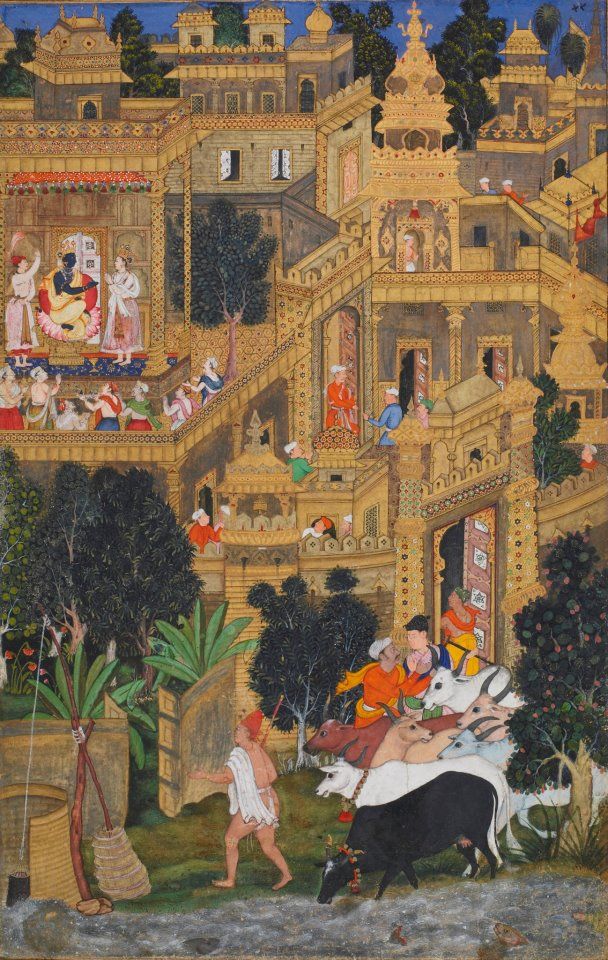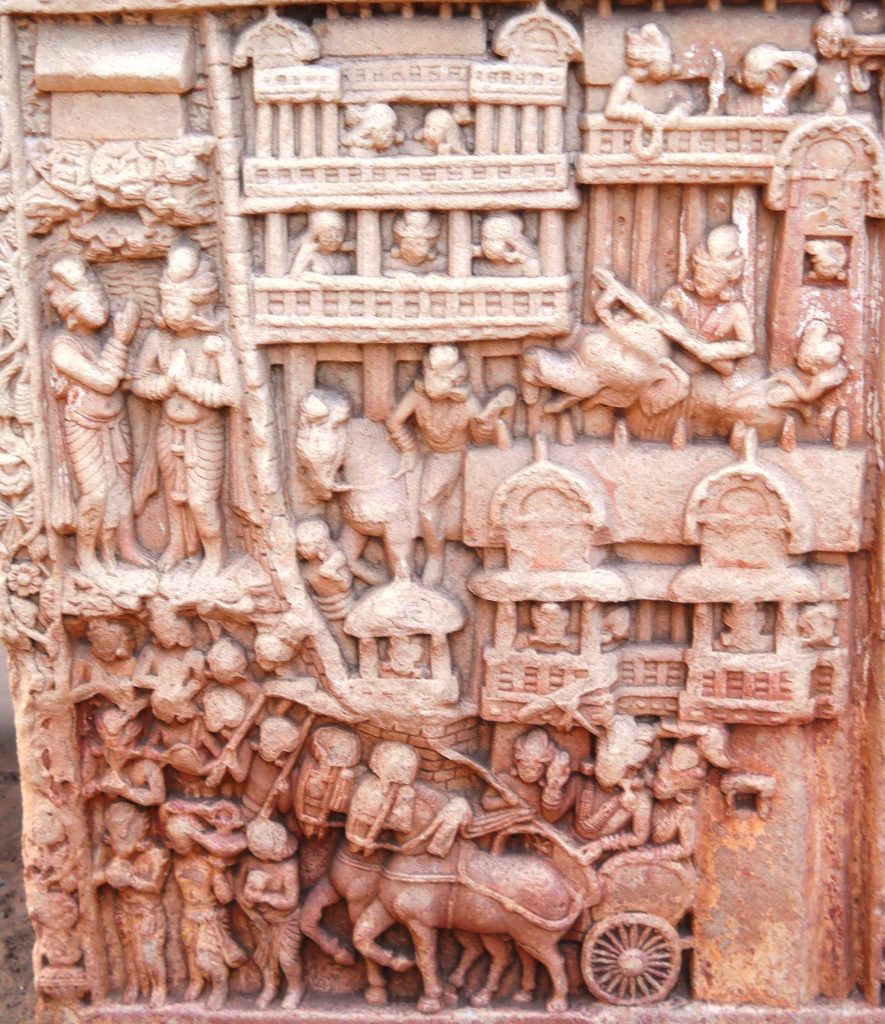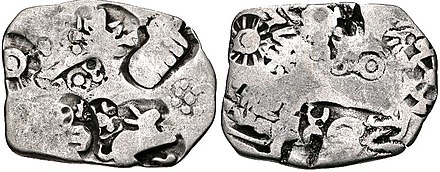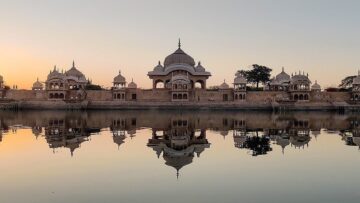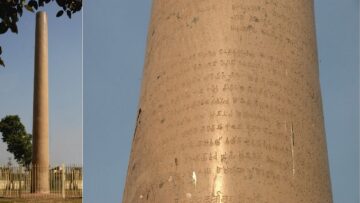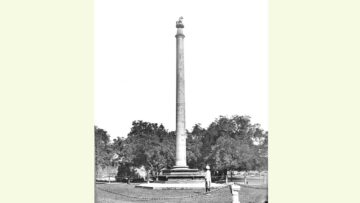Today we see cities swarming with people, packed with trains, buses and cars and the entire city skyline dominated by massive buildings. Have we ever wondered what was the kind of cities in which our ancestors lived in ancient times? The cities of the Sindhu-Sarasvatī Civilisation were the first wave of urbanisation that the Indian Subcontinent experienced.
After the decline of these urban centres the Subcontinent witnessed its second phase of urbanisation but this time its geographical location was the Gaṅgā Valley. When we speak about ancient cities we cannot in any way compare them with their modern counterparts. The level and extent of urbanisation of the cities of yore was on a much-limited scale in comparison to the present cities.
The Gaṅgā Valley was home to a major Iron Age Culture known as the Painted Grey Ware Culture. It is believed that the invention, use and dissemination of iron technology was a crucial game-changer in the history of India. The origin of iron rather than being uni-centric is now accepted as being poly-centric. The Vedic people were certainly aware of the use of iron. The word ‘kṛṣṇa āyasa‘ which appears in the Vedic texts is interpreted by some scholars as iron.
Though the Painted Grey Ware Culture was essentially a rural one, it paved the way for the Second Urbanisation. The vast plains of the Gaṅgā with their rich deposits of alluvium offered wide opportunities for agriculture. Agriculture made it mandatory for people to settle down in one area and this is how people’s attachment to a piece of land or a territory grew.
This gave rise to politico- geographical units with a well-defined territory and it was these units which grew into fairly large kingdoms by the 6th century BCE.
The expansion of agriculture and the consequent stationary life led to an increase in the number of settlements in the Gaṅgā Valley. Hastināpura, Atranjikherā, Noh and Bairat (Virāṭanagara) were some of the noteworthy sites which have provided evidence of the Painted Grey Ware Culture. The use of iron ushered in long-standing changes in the areas of agriculture, transport and trade. The iron ploughshare was used to till the thick layers of the alluvial soil in the Gaṅgā Plains.
Certain historians have stated that large tracts of land covered with forests were cleared for agriculture with the use of iron implements. However in reality, extensive tracts of forest lands were cleared by the use of fire and not iron tools. This period also witnessed the fruition of the state forming process which had its beginnings in the Vedic period.
Villages (janapadas) were brought together to form the Mahājanapadas and the references to these Mahājanadas are found in the Mahābhārata as well as Buddhist and Jaina texts.
All these Mahājanapadas had a capital city and in the 6th century BCE, Campā (Aṅga), Rājagriha (Magadha), Śrāvasti (Kosala), Sāketa (Kosala), Kauśambī (Vatsa) and Vārāṇasī (Kāsī) were the six great cities. However, the process by which these cities reached this stature is not very clear.
Before we proceed further, let us try to understand what a city exactly is. A. Ghosh has enumerated the following features of a city:
a. The population in a city is denser than a village and people live in a restricted area.
b. Only a small area, if at all is used for farming purposes.
c. People living in the city, in most cases practise occupations which are not related to agriculture and are dependent on the villages for their food and raw materials supply.
A city could be an administrative or a political centre or it could be a hub of economic activities. It might even be a religious centre or might be a combination of more than one of these aspects. However, they will all conform to the above-mentioned criteria. Just mere growth in population is not responsible for the growth of the village into a city. Archaeologists like V.G. Gordon Childe considered surplus in the agrarian production as the main mover in this process. However, it is again difficult to ascertain whether the surplus was deliberate or accidental.
In the Indian context, purposeful production of surplus seems difficult since Indian agriculture was always plagued with droughts and floods. On the other hand scholars like Sjoberg have highlighted the role of kings in the establishment of cities. The Uttara Kāṇḍa of the Vālamīki Rāmāyaṇa and the Harivaṁśa describe how Śatrughna, the younger brother of Lord Rāma killed a demon called Lavaṇāsura and created the city of Mathurā. We also have the example of King Ajātaśatru of Magadha who founded the city of Pāṭaliputra (modern Patna) on the banks of the river Gaṅgā.
Even if the economic or commercial base of a settlement was strong, state support is a requisite for the settlement to expand into a city. The structure of a city needs a direct at least an indirect support of the state. Trade and merchants also had a lion’s share in the emergence of cities. Merchants were an integral part of the Early Historical Indian city. It is difficult for a city to survive in the absence of a merchant class which supports its economy.
Many historians and archaeologists have deliberated and debated about the characteristics of a city which distinguish it from other kinds of settlements. Here we have used one of the most well-known arguments as put forward by archaeologist V.G. Gordon Childe which is as follows:
1. The cities were larger in size than villages and their population was denser in comparison to the villages.
2. The farmers would cultivate the land outside the villages. The cities mainly had as their population base the non-food producing classes like full-time craftsmen, charioteers, merchants, state officials and priests who must have been supported by the surplus produced by the farmers.
3. The king collected the surplus in the form of tax. Starting from the Vedic period and continuing right till the 7th-8th centuries CE, the taxes imposed by Indian kings were very low. As reflected in our ancient taxes, collecting high taxes was severely condemned.
4. Cities had monumental structures which were categorised as public architecture.
5. Systems of recording data and useful sciences were an important feature of urbanisation.
6. Various writing systems were invented. Though in India, knowledge was transferred mainly through oral traditions, it did not undermine the use of writing. Evidence of writing can be clearly seen from the inscriptions of Aśoka (3rd century BCE) though the antiquity of the scripts that he used, namely Brāhmī and Kharoṣṭhī could even go further back. The use of writing helped in the formulation of exact and predictive sciences like astronomy, arithmetic and grammar or Vyākaraṇa
7. A class fully engaged in the pursuit of arts and crafts became active in the cities. Arts like painting, sculpture, dance and music developed. The Vedic texts project a society with a high level of craft specialisation. We are informed about different kinds of specialised vocations like carpenters, potters, smiths and charioteers.
8. Another feature of cities was the brisk trade carried on. The surplus was used to import raw materials which led to the formation of long-distance exchange networks. Money economy soon replaced the barter system, at least to some extent.
9. The artists and craftsmen were supplied with raw materials which enabled them to use their expertise. They were given state protection as well.
After surveying the general features of a city, let us cast a glance on the factors that contributed to the Second Urbanisation. We have already discussed the role of iron technology. Use of iron technology helped the farmers to reap in a good harvest which included the surplus.
A society must have a substantial base of surplus produce before it could become an urban settlement. A wide variety of crops have been found in excavations across India. Surplus enabled many people to choose full-time occupations other than agriculture and a sizeable number of the population started pursuing other vocations. This helped in the overall growth of the society.
People could now single-mindedly devote their time and energy for artistic and intellectual pursuits. We have also spoken about the rise of the Mahājnapadas. There were intermittent struggles between the Mahājanapadas and some of the prominent ones were Magadha, Kāṣī, Kosala, Vatsa, Śurasena, Gāndhāra, Kambhoja, Kuru, Pāñcāla, Aṅga, Avantī and Aśmaka.
There were in all sixteen Mahājanapadas and eventually Magadha superseded all of them to emerge as the single largest Mahājanapada and ultimately a vast empire or sāmrājya under the visionary guidance of Cāṇākya and the able leadership of Candragupta Maurya. The capitals of these Mahājanapadas became centres of centralised political power.
Some cities were also centres of economic power and commerce. Such cities were called ‘nigamas‘. Certain cities were also market towns which served as strategic trade stations for the exchange of merchandise. Major trade routes passed through these cities. The flowering of new religious ideas embodied by Buddhism and Jainism played vital roles, albeit indirectly, in the growth of cities.
Buddhism was essentially an urban religious thought and the Buddha himself encouraged people to engage in trade. The Jātaka stories abound in details about the trading communities and trade. Most of the places associated with the Buddha-like Srāvastī and Vaiśālī were urban centres. Many of the Buddha’s followers were traders and they financed the Buddhist establishments.
Let us now review how the above features are reflected in the Indic context. The culture which succeeded the Painted Grey Ware Culture was characterised by pottery known as the Northern Black Polished Ware (NBPW) which became almost a pan Indian pottery by the Mauryan Age.
The number of NBPW settlements was much higher than the Painted Grey Ware settlements. Fieldwork done by archaeologists like Makkhan Lal and Erdosy brought to light many new settlements. This indicates an increase in the size of the population.
Apart from the River Gaṅgā, her tributaries also came to used for settlements. The population of the city of Pāṭaliputra was estimated to be around 2, 70,000 in the Mauryan Age. By this time India was marked with cities like Takṣaśīlā, Puṣkalāvatī, Rājagriha, Kapilavastu, Kauśāmbī, Ahichchatra, Śrāvastī, Mathurā, Ujjayinī, Vidiśā, Tośālī, Mahāsthāna, Sannati and Dhānyakaṭaka. These cities were of varying sizes and populations.
A far as the surplus was concerned, it was used to support the non-food-producing population groups like merchants, artisans and monks. Though we do not get clear evidence of public buildings in the excavations, a huge stone wall was unearthed at Rājagriha. Earthen ramparts and moats have been found at many urban sites like Kauśāmbī and Ujjayinī. Many of these ramparts were in the form of embankments.
By the 6th century BCE, we had a well established ruling class. There were two types of governance systems, namely monarchy and oligarchy. The Mahājanapada of Magadha was a monarchy i.e. ruled by a single king whereas the Vrajjis were a gaṇasangha or an oligarchy i.e. they were governed by a group of select people. The Śākyas (the clan of Guatama Buddha) was also an oligarchy. The monarchical government reached its pinnacle in the Mauryan Age. The Mauryan Age also provides clear evidence of writing systems with well-formed scripts.
As far as the system of writing was concerned, we do not get any evidence of writing in the 6th century BCE. However, this does not imply that writing did not exist then. Some kind of graffiti has been found on potsherds belonging to the Deccan Chalcolithic and Megalithic Cultures. Prof. B.B. Lal who studied these potsherds found a similarity between their graffiti and the Sindhu-Sarasvati Civilisation Script.
We have not yet come across too many art objects which could be accurately dated to the 6th century BCE. Art objects recovered from the stupas at Lauriya Nandangarh and Piprahawa may belong to the 6th-5th centuries BCE. A few ‘mother goddess’ figurines were found from Mathurā which are considered to be pre-Mauryan. There are some pillars which are very similar to Aśokan pillars might be dated to the 4th century BCE though this dating may be subjected to debate.
By the 6th century BCE, inland trade was well established. The origins of mercantile guilds can also be dated to the same period. The heads of the guilds or śrenis were known as śreṣthins and they were well respected in the society. The caravan merchants were the sārthavāhas. The caravans would carry goods over long distances. There might have been some kind of foreign trade with the Achaemenian Empire of Persia through the city of Takṣaśīlā. Wood from India was used in the Achaemenian palace at Persepolis.
Also dates back to the 6th century BCE. Many of the Mahājanapadas issued their own punch-marked coins in silver. Full-fledged silver currency was introduced in India. By this period, India had made great progress in the fields of astronomy, arithmetic and geometry. The Śulbha Sūtras and Śrauta Sūtras give detailed descriptions about the construction of fire altars for yajñas. Astronomy or Jyotiṣa was one of the six Vedāṅgas and was used to fix the exact date and time of Vedic yajñas. The science of grammar was well advanced as is reflected in the works of Yāska and Pāṇini.
The process of the Second Urbanisation that was inaugurated in the 6th century BCE attained its zenith during the reigns of the Mauryan kings. Cities like Mathurā developed into full-fledged urban spaces in the Kuṣāṇa period (1st century CE -3rd century CE). The Deccan and Southern India also experienced their own phases of urbanisation under the rule of the Sātavāhanas, the early Colas and Pāṇḍyas.
References:
Ghosh A, The City in Early Historical India, Shimla: Indian Institute of Advanced Study, 1973.
(Ancient Indian Economy Part I, Part II, Part III, Part IV, and Part V )
Featured Image Credits: (DEVA) Devashish pradhan – artstation
Disclaimer: The opinions expressed in this article belong to the author. Indic Today is neither responsible nor liable for the accuracy, completeness, suitability, or validity of any information in the article.

